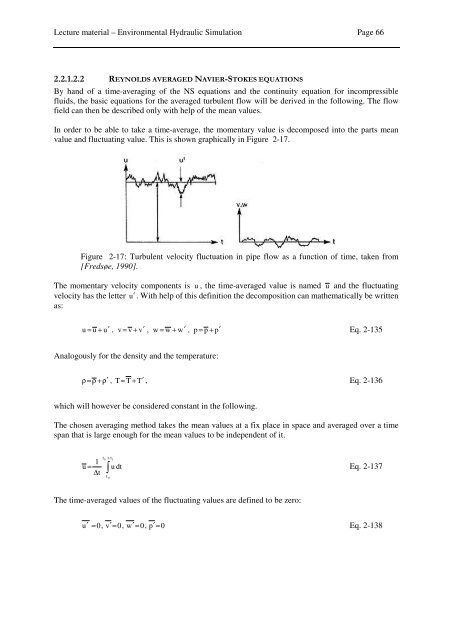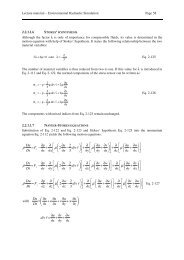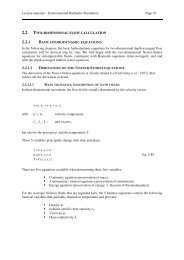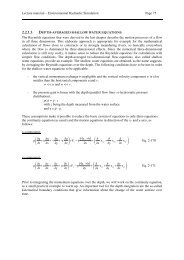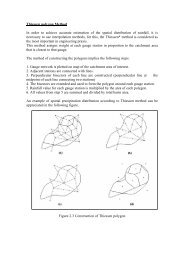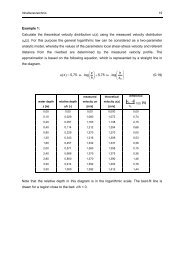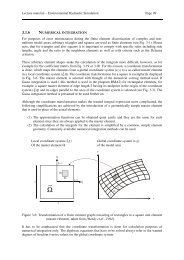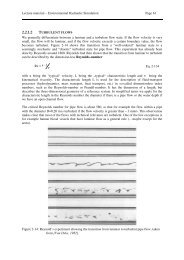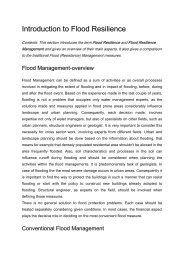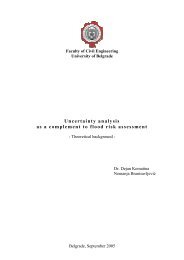Reynolds average Navier-Stokes equation
Reynolds average Navier-Stokes equation
Reynolds average Navier-Stokes equation
Create successful ePaper yourself
Turn your PDF publications into a flip-book with our unique Google optimized e-Paper software.
Lecture material – Environmental Hydraulic Simulation Page 66<br />
2.2.1.2.2 REYNOLDS AVERAGED NAVIER-STOKES EQUATIONS<br />
By hand of a time-averaging of the NS <strong>equation</strong>s and the continuity <strong>equation</strong> for incompressible<br />
fluids, the basic <strong>equation</strong>s for the <strong>average</strong>d turbulent flow will be derived in the following. The flow<br />
field can then be described only with help of the mean values.<br />
In order to be able to take a time-<strong>average</strong>, the momentary value is decomposed into the parts mean<br />
value and fluctuating value. This is shown graphically in Figure 2-17.<br />
Figure 2-17: Turbulent velocity fluctuation in pipe flow as a function of time, taken from<br />
[Fredsøe, 1990].<br />
The momentary velocity components is u , the time-<strong>average</strong>d value is named u and the fluctuating<br />
velocity has the letter u′ . With help of this definition the decomposition can mathematically be written<br />
as:<br />
u = u + u′<br />
, v = v + v′<br />
, w = w + w′<br />
, p = p + p′<br />
Eq. 2-135<br />
Analogously for the density and the temperature:<br />
ρ = ρ +ρ′ , T = T + T′<br />
, Eq. 2-136<br />
which will however be considered constant in the following.<br />
The chosen averaging method takes the mean values at a fix place in space and <strong>average</strong>d over a time<br />
span that is large enough for the mean values to be independent of it.<br />
t + t<br />
0 1<br />
1<br />
u =<br />
∆ ∫ u dt<br />
Eq. 2-137<br />
t<br />
t<br />
0<br />
The time-<strong>average</strong>d values of the fluctuating values are defined to be zero:<br />
u ′ = 0, v′=<br />
0, w′=<br />
0, p′<br />
= 0<br />
Eq. 2-138
Lecture material – Environmental Hydraulic Simulation Page 67<br />
Firstly the continuity <strong>equation</strong> is <strong>average</strong>d. If we substitute the expressions for the velocities from Eq.<br />
2-135 into the continuity <strong>equation</strong> (see Eq. 2-131) we get:<br />
∂u<br />
∂u′<br />
∂v<br />
∂v′<br />
∂w<br />
∂w′<br />
+ + + + + = 0<br />
∂x<br />
∂x<br />
∂y<br />
∂y<br />
∂z<br />
∂z<br />
Eq. 2-139<br />
The time-<strong>average</strong> of the last <strong>equation</strong> is written as:<br />
∂u<br />
∂u′<br />
∂v<br />
∂v′<br />
∂w<br />
∂w′<br />
+ + + + + = 0<br />
∂x<br />
∂x<br />
∂y<br />
∂y<br />
∂z<br />
∂z<br />
Eq. 2-140<br />
Before we look at the transformation and reduction of Eq. 2-140, a summary of rules for timeaveraging<br />
shall be given:<br />
∂u<br />
∂x<br />
=<br />
1<br />
∆t<br />
to<br />
+ t1<br />
∫<br />
t 0<br />
∂u<br />
dt =<br />
∂x<br />
1<br />
x ∆t<br />
∂<br />
∂<br />
to<br />
+ t1<br />
∫<br />
t0<br />
u dt =<br />
∂u<br />
∂x<br />
Eq. 2-141<br />
∂u′<br />
∂x<br />
=<br />
1<br />
∆t<br />
t o + t1<br />
∫<br />
t0<br />
∂u′<br />
dt =<br />
∂x<br />
∂<br />
∂<br />
1<br />
x ∆t<br />
t o + t1<br />
∫<br />
t0<br />
u′<br />
dt =<br />
0<br />
f<br />
∂f<br />
∂f<br />
= f , f + g = f + g , f ⋅ g = f ⋅ g , = , f ds =<br />
∂s<br />
∂s<br />
∫ ∫<br />
f<br />
ds<br />
Eq. 2-142<br />
but<br />
f<br />
⋅ g ≠<br />
f<br />
⋅ g<br />
The <strong>average</strong>d derivatives of the fluctuations are also zero according to these rules, so that the time<strong>average</strong>d<br />
continuity <strong>equation</strong> is:<br />
∂u<br />
∂v<br />
∂w<br />
+ + = 0<br />
∂x<br />
∂y<br />
∂z<br />
Eq. 2-143<br />
Now the NS <strong>equation</strong>s will be time-<strong>average</strong>d. The averaging will be exemplified for the x-component.<br />
Beforehand a small transformation of the advection term from Eq. 2-131:<br />
∂u<br />
∂u<br />
∂u<br />
∂<br />
u + v + w =<br />
∂x<br />
∂y<br />
∂z<br />
∂x<br />
∂<br />
=<br />
∂x<br />
2<br />
( u ) ∂( uv) ∂( uw)<br />
2<br />
( u ) ∂( uv) ∂( uw)<br />
+<br />
+<br />
∂y<br />
∂y<br />
+<br />
+<br />
∂z<br />
∂z<br />
⎛ ∂u<br />
∂v<br />
∂w<br />
⎞<br />
− u<br />
⎜ + +<br />
x y z<br />
⎟<br />
⎝ ∂ ∂ ∂<br />
<br />
<br />
⎠<br />
= 0<br />
Eq. 2-144
Lecture material – Environmental Hydraulic Simulation Page 68<br />
The expressions for the decomposition of the velocities from Eq. 2-135 are now substituted into the<br />
transformed <strong>Navier</strong>-<strong>Stokes</strong> <strong>equation</strong> (see Eq. 2-131) and a time-<strong>average</strong> is done:<br />
⎧∂<br />
ρ ⎨<br />
⎩<br />
2<br />
( u + u′<br />
) ∂( u + u′<br />
) ∂( u + u′<br />
)( v + v′<br />
) ∂( u + u′<br />
)( w + w′<br />
)<br />
∂t<br />
+<br />
∂x<br />
+<br />
∂y<br />
+<br />
∂z<br />
⎫<br />
⎬<br />
⎭<br />
=<br />
F<br />
<br />
is not subject to<br />
turbulent<br />
fluctuation<br />
∂<br />
−<br />
2<br />
2<br />
2<br />
( p + p′<br />
) ⎛ ∂ ( u + u′<br />
) ∂ ( u + u′<br />
) ∂ ( u + u′<br />
)<br />
∂x<br />
+<br />
x<br />
µ<br />
⎜<br />
⎝<br />
∂x<br />
2<br />
+<br />
∂y<br />
2<br />
+<br />
∂z<br />
2<br />
⎞<br />
⎟<br />
⎠<br />
Eq. 2-145<br />
Application of the rules from Eq. 2-141 and Eq. 2-142 shows that among others the terms<br />
∂( u<br />
iu′<br />
j<br />
) ∂u′<br />
i<br />
∂u′<br />
i<br />
, , from the <strong>equation</strong> above can be reduced and the <strong>equation</strong> can be transformed to:<br />
∂x<br />
∂t<br />
∂x<br />
j<br />
j<br />
⎛ u uu u u uv u v u w uw ⎞<br />
⎜<br />
∂ ∂ ∂ ′ ′ ∂ ∂ ′ ′ ∂ ′ ′ ∂<br />
ρ<br />
⎟<br />
+ + + + + +<br />
t x x y y z z<br />
⎝ ∂ ∂ ∂ ∂ ∂ ∂ ∂ ⎠<br />
= F<br />
x<br />
∂p<br />
−<br />
∂x<br />
2 2 2<br />
⎛ ∂ u ∂ u ∂ u ⎞<br />
+µ<br />
⎜ + +<br />
2 2 2<br />
x y z<br />
⎟<br />
⎝ ∂ ∂ ∂<br />
<br />
⎠<br />
∆ u<br />
Eq. 2-146<br />
Further small transformations, for example a repeated application of the product rule and the<br />
continuity <strong>equation</strong> to the advection term, lead to a form of the time-<strong>average</strong>d NS <strong>equation</strong>s for all<br />
three directions as:<br />
⎛ ∂u<br />
∂u<br />
∂u<br />
∂u<br />
⎞<br />
ρ<br />
⎜ + u + v + w<br />
⎟ = F<br />
⎝ ∂t<br />
∂x<br />
∂y<br />
∂z<br />
⎠<br />
x<br />
∂p<br />
⎛<br />
⎞<br />
⎜<br />
∂u′<br />
u′<br />
∂u′<br />
v′<br />
∂u′<br />
w′<br />
− +µ ∆ u −ρ<br />
⎟<br />
+ +<br />
∂x<br />
⎝ ∂x<br />
∂y<br />
∂z<br />
⎠<br />
⎛<br />
⎞<br />
⎜<br />
∂v<br />
∂v<br />
∂v<br />
∂v<br />
ρ<br />
⎟<br />
+ u + v + w<br />
= F<br />
⎝ ∂t<br />
∂x<br />
∂y<br />
∂z<br />
⎠<br />
y<br />
∂p<br />
⎛<br />
⎞<br />
⎜<br />
∂u′<br />
v′<br />
∂v′<br />
v′<br />
∂v′<br />
w′<br />
− +µ ∆ v −ρ<br />
⎟<br />
+ +<br />
∂y<br />
⎝ ∂x<br />
∂y<br />
∂z<br />
⎠<br />
Eq. 2-147<br />
⎛ ∂w<br />
∂w<br />
∂w<br />
∂w<br />
⎞<br />
ρ<br />
⎜ + u + v + w<br />
⎟ = F<br />
⎝ ∂t<br />
∂x<br />
∂y<br />
∂z<br />
⎠<br />
z<br />
∂p<br />
⎛<br />
⎞<br />
⎜<br />
∂u′<br />
w′<br />
∂v′<br />
w′<br />
∂w′<br />
w′<br />
− +µ ∆ w −ρ<br />
⎟<br />
+ +<br />
∂z<br />
⎝ ∂x<br />
∂y<br />
∂z<br />
⎠<br />
Or in tensor form:<br />
D ui<br />
∂ p<br />
⎛ ∂ u′<br />
i<br />
u′<br />
⎞<br />
j<br />
ρ = Fi<br />
− + µ ∆ u ⎜ ⎟<br />
i<br />
− ρ<br />
Eq. 2-148<br />
Dt ∂x<br />
⎜<br />
i<br />
x ⎟<br />
⎝<br />
∂<br />
j<br />
⎠<br />
Re ynolds−stress
Lecture material – Environmental Hydraulic Simulation Page 69<br />
From now on the time-<strong>average</strong>d fields will not be overlined anymore. So for example u stands for the<br />
time-<strong>average</strong>d velocity component in direction of the x-axis.<br />
We pay attention to the last two terms of the right side of Eq. 2-148:<br />
µ ∆ u<br />
i<br />
⎛ ⎞<br />
⎜<br />
∂u′<br />
′<br />
iu<br />
j<br />
− ρ ⎟<br />
⎜ ∂x<br />
⎟<br />
⎝<br />
j<br />
⎠<br />
= µ<br />
∂<br />
∂x<br />
j<br />
⎛<br />
⎜<br />
∂u<br />
⎝<br />
∂x<br />
i<br />
j<br />
⎞<br />
⎟ − ρ<br />
⎠<br />
∂<br />
∂x<br />
j<br />
( u′<br />
u′<br />
)<br />
i<br />
j<br />
Eq. 2-149<br />
=<br />
∂<br />
∂x<br />
j<br />
⎛<br />
⎜<br />
∂u<br />
µ<br />
⎝<br />
∂x<br />
i<br />
j<br />
− ρu′<br />
u′<br />
i<br />
j<br />
⎞<br />
⎟<br />
⎠<br />
The expression in the brackets above corresponds to the total shear stress:<br />
∂u<br />
i<br />
τ<br />
ij<br />
= µ − ρ u ′<br />
i<br />
u ′<br />
j<br />
Eq. 2-150<br />
∂x<br />
j<br />
If we compare to the <strong>Navier</strong>-<strong>Stokes</strong> <strong>equation</strong>s Eq. 2-131, it is conspicuous that besides the viscous part<br />
an additional term has been added to the total shear stress. This term results from the time-<strong>average</strong> and<br />
is generally the dominant part of the total shear stress. Since the term only appears due to the <strong>Reynolds</strong><br />
<strong>average</strong>, it is called <strong>Reynolds</strong> stress or apparent turbulent shear stress. As stated in the introduction to<br />
the RANS approach, to lead to the closure of the <strong>equation</strong> system, an approximation for the <strong>Reynolds</strong><br />
stresses has to be done, which sets in relation the apparent shear stresses with the velocity field of the<br />
<strong>average</strong> flow.<br />
With the approach of the eddy viscosity principle after Boussinesq 1877, the general time-<strong>average</strong>d<br />
NS <strong>equation</strong>s, also called <strong>Reynolds</strong> <strong>equation</strong>s, can thus be written in tensor form as:<br />
⎛ Dui<br />
ρ ⎜<br />
⎝ Dt<br />
⎞<br />
⎟<br />
⎠<br />
=<br />
F<br />
i<br />
−<br />
∂p<br />
∂x<br />
i<br />
+<br />
∂<br />
∂x<br />
j<br />
τ<br />
ij<br />
Eq. 2-151<br />
with<br />
τ<br />
ij<br />
∂u<br />
= µ<br />
∂x<br />
i<br />
j<br />
⎛<br />
+ ρ ⎜ν<br />
T<br />
⎜<br />
⎝<br />
⎛<br />
⎜<br />
∂u<br />
⎝ ∂x<br />
i<br />
j<br />
∂u<br />
j<br />
+<br />
∂x<br />
i<br />
⎞<br />
⎟ −<br />
⎠<br />
2<br />
3<br />
⎞<br />
k δ ⎟<br />
ij<br />
⎟<br />
⎠


